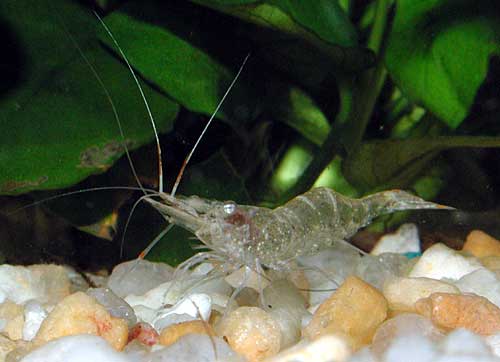I have a ghost shrimp in my saltwater tank. I've read how they require salt or brackish water for reproducing. If there was more than one, would it possibly reproduce in the tank?
RN
Ghost shrimp in saltwater
Moderator: Mustafa
It depends on what species you have in mind. "Ghost shrimp" is a truly vague term applied to a broad range of species - ranging from freshwater to estuarine-brackish and pure marine conditions - of the Palaemonidae. A more specific specification of taxonomy would be helpful, as breeding conditions are analogously myriad (the vast majority of true freshwater ghost shrimp (Palaemonetes) breed and live in freshwater; some "freshwater" ghost shrimp are actually brackish to marine (some species have truly broad salinity tolerance), as Palaemonetes pugio, but will never thrive in full freshwater, and will reproduce only under optimum salinity (that is, at least somewhat salty water). Compounding the matter is the fact that there are true clades of outwardly similar, yet fully marine "ghost shrimp" (sometimes "glass shrimp", "grass shrimp", or, more broadly, "prawns") - Palaemon and associated genera, as well as some Macrobrachium sp. ("long-arm shrimp" or "freshwater prawns") that can tolerate salty conditions. Many unrelated crustaceans are termed "ghost shrimp" as well: callianasids - not shrimp at all, but actually allied with hermit crabs and burrow-dwellers in muddy substrate, and some free-living commensal shrimp, as certain Stenopus, closely related to "banded coral shrimp".
Look to the following illustrated key:
Palaemonetes sp.: freshwater (will not last long, if acclimated, in marine conditions & generally breeds in freshwater): color ranges from nearly fully transparent (as per the titular denomination), excepting certain internal organs, to slightly gold- or red-tinged.

Another freshwater (sometimes marginally brackish) P. antennarius, of the Mediterranean rim:

Crangon: a saltwater denizen; no special salinity changes required for breeding.


What is probably Palaemon (or quite possibly even Macrobrachium) sp., captured in brackish-marine conditions.

Palaemon sp. - the marine 'feeder' "ghost shrimp" you most likely are referrring to; full saltwater - is capable of being bred in captivity (planktonic larvae are quickly consumed by other aquarium inhabitants, though).

A beautiful saltwater Palaemon sp.

Yes, they can be bred in captivity: see http://yamada.cside.com/small/lives/l99032.html for some excellent pictures of eggs, zoea, and adults (scroll down).
Look to the following illustrated key:
Palaemonetes sp.: freshwater (will not last long, if acclimated, in marine conditions & generally breeds in freshwater): color ranges from nearly fully transparent (as per the titular denomination), excepting certain internal organs, to slightly gold- or red-tinged.

Another freshwater (sometimes marginally brackish) P. antennarius, of the Mediterranean rim:

Crangon: a saltwater denizen; no special salinity changes required for breeding.


What is probably Palaemon (or quite possibly even Macrobrachium) sp., captured in brackish-marine conditions.

Palaemon sp. - the marine 'feeder' "ghost shrimp" you most likely are referrring to; full saltwater - is capable of being bred in captivity (planktonic larvae are quickly consumed by other aquarium inhabitants, though).

A beautiful saltwater Palaemon sp.
Yes, they can be bred in captivity: see http://yamada.cside.com/small/lives/l99032.html for some excellent pictures of eggs, zoea, and adults (scroll down).
- Shrimpmania
- Shrimp

- Posts: 109
- Joined: Sun Dec 26, 2004 9:13 pm
- Location: S'pore
In that case, without any acclimation (which probably would not have been successful), the shrimp will quickly die (from salinity shock if not predation), if it has not done so already; breeding is out of the question. Coloration is often quite variable even within a species, and is contingent on a variety of environmental factors.renichms wrote:The one I tossed in was a freshwater feeder, though I noticed no red markings on it like I see on the ones in my turtle tank.RN
It's still alive and cleaning the tank. I had hoped to test if anything would eat it but nothing seems interested, so it seems to be at least a temporary resident.Veneer wrote:In that case, without any acclimation (which probably would not have been successful), the shrimp will quickly die (from salinity shock if not predation), if it has not done so already; breeding is out of the question. Coloration is often quite variable even within a species, and is contingent on a variety of environmental factors.renichms wrote:The one I tossed in was a freshwater feeder, though I noticed no red markings on it like I see on the ones in my turtle tank.RN
RN
